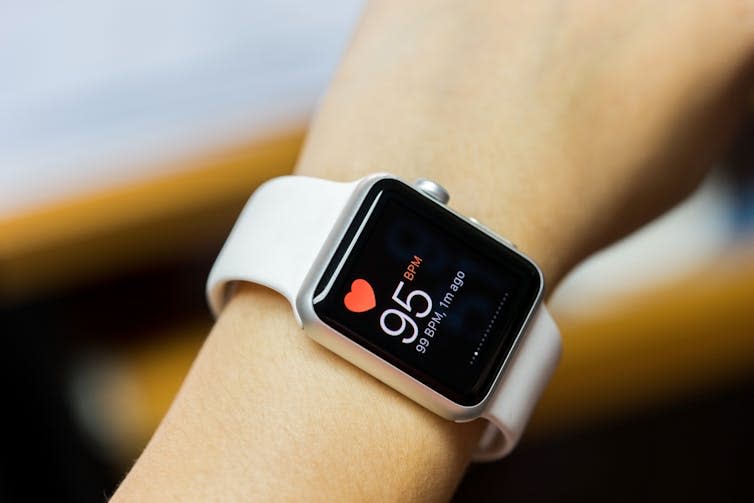Web and mobile services try to understand users’ desires and goals by analyzing how they interact with their platforms. Smartphones, for example, capture online data from users on a large scale and at low cost.
Policy makers have responded by implementing mechanisms to mitigate the inherent risks of technology companies storing and processing citizens’ private information, such as health data.
Wearable devices are becoming increasingly prominent in this discussion due to their ability to continuously collect data, without the wearer being aware of it. Wearables such as smart watches collect a range of measurements on your well-being, such as sleep patterns, activity levels and heart fitness.
Today, there are portable devices to obtain high-quality data from brain activity, eye trackers, and the skin (to detect temperature and sweat). Consumers can buy small devices to measure the body’s responses that were only available exclusively to research institutions a few decades ago.
Although wearable products are commercially focused on health monitoring, researchers have long looked forward to capturing other types of data on a user. A computer that could collect useful information related to a person’s brain activity, heart and skin function, or their movement patterns would be able to understand an enormous amount about the user.
But it is AI that could create a game changer. Smaller wearables combined with AI algorithms to process the data could produce tools that augment and increase our goals and performance in life. But this collection of information also has its drawbacks.
Daily routines
Let’s imagine a world where societies play a more significant role every day. Smart beds could wake us up at the perfect time to rest by reading our body temperature, respiration and brain activity. Smart kitchens could help us eat healthier, preparing an adapted diet based on chemical cues in our bloodstream (biomarkers). A smart bike would automatically change gears based on the changing inclination of the terrain, and our fitness levels, to support an effective workout.
Smart glasses could analyze pupil responses in our eyes and overall eye movements to give us content we’re likely to enjoy (backed by AI algorithms). Video calls could evolve into full-body 3D holograms of friends and family. Finally, immersive entertainment could be projected in our living rooms or contained in headphones to become 360 degree experiences rather than being limited to flat screens.

Although it seems futuristic, hardware manufacturers are already trying to move screens and devices out of our hands. For example, Mobile World Congress 2024 showed several smart watches, an AI “pin” device made by the company Humane that could eliminate the need for a screen by projecting images on the user’s hands, or the Air Glass smart glasses 3 XR.
Other companies have also recently released wearable devices such as the Ray-Ban Meta, the Apple Vision Pro, or the Meta Quest 3. A device called the Galea project is a type of helmet that can be attached to capture XR headsets. data from facial muscles, the brain, eyes, the skin and heart.
This is clearly more invasive than a smart ring or smart glasses. It allows researchers to explore what digital services might look like in the future if computers had access to a range of data from the human body. This data would go far beyond what they can currently access – like we do on our smartphones.
In general, physical data from wearable devices could fundamentally change the way we interact with computers and the internet. In 2007, the audience at an Apple product launch was in awe as Steve Jobs scrolled on an iPhone for the first time, introducing an intuitive interaction that the whole world would eventually become convinced of.
Likewise, wearables and headsets would replace smartphones with our hands and require new forms of interaction with technology. Current prototypes suggest using our eye sight to make gestures and hand gestures in mid-air to click. However, this implies that these systems must continuously collect data on the user’s body.
Digital dominance
Big data sets based on responses from the human body could easily weave the design of digital tools into our daily lives to unlock highly personalized capabilities. This includes the smart bed and the smart kitchen which can recommend an adapted diet.
The next wave of the internet is being designed around data decentralization – where users can have greater control over how their data is used. This may prevent misuse of personal information.
For example, the inventor of the World Wide Web, Tim Berners Lee, is working on something called Solid. This open source initiative allows people to manage their data on personal web servers and choose which organizations can access them.
Instead of requiring people to create an account for every service they want to use, Solid would provide a protocol for building what the project refers to as online personal data stores. This would be a way to allow users to host their personal data on their own computer or, alternatively, choose a trusted provider to host it based on their reputation and physical location.
To really secure these initiatives, however, would require proactive legislation towards digital sovereignty – a person’s right to control their own digital data. This would guarantee an internet that takes privacy seriously.
In the era of wearables and powerful AI systems, a decentralized approach to the internet would be key to allowing citizens to reap the benefits of these technological advances while owning their data at the same time. This would move us towards enabling citizens to make active decisions about where their data is stored, who can access it, and for what purposes.
This article from The Conversation is republished under a Creative Commons license. Read the original article.


Luis Quintero does not work for, consult with, or own shares or receive funding from any company or organization that would benefit from this article this, and did not disclose any relevant connections beyond their academic appointment.